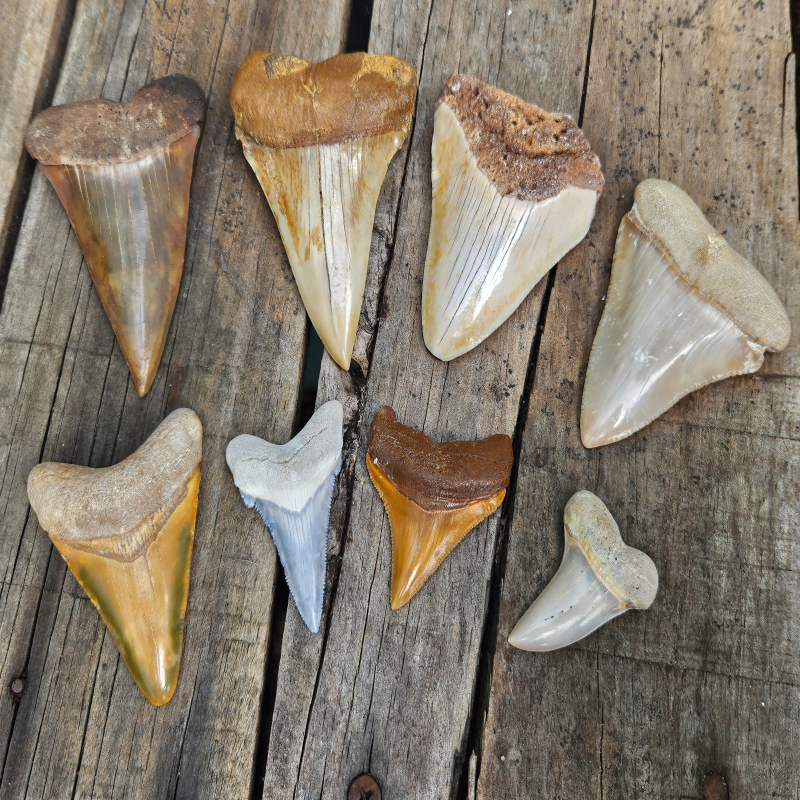Have a Question?
How much is a sharks tooth worth
There are different factors that determine the value of a shark tooth such as Size, condition, Colors, Locality, Media events such as shark week, Megalodon movies, Gifting occasions Christmas, birthdays, 2 or more very serious collectors battling over having the best specimens in their collections, etc.
Here are the Factors that determine a sharks tooth value
Size and Condition are the first consideration
Size is an important factor in determining the value of a shark tooth. The Majority of teeth are measured from the tip to the longest of the 2 root sides.
Generally speaking the larger the tooth Measurement the larger the shark. Some species get larger than others. Adult Megalodon teeth get up to the 7″ inch range . Whereas Adult Giant thresher teeth get up to 2″. A two-inch Thresher is worth more than a 4″ megalodon because of its rarity in size.
Here is a general guide on where teeth explode in price. I will not put an exact price as there are other variables that can affect the price such as Locality, the current economy, media events such as the Meg Movie, Shark Week, Christmas, 2 or more serious Collectors fighting to control the market on certain species
These size ranges are based on hardcore divers who dive for a living
Megalodon Teeth
The average size is 3.5-4.5″‘
Less common 5″
Rare is 6″
Very rare 6.5″
extremely rare 6.75″
Once in a lifetime 7″ plus
Great white shark teeth
The average size is 2″ to 2 1/4″
Less common 2 1/4″
Rare is 2 1/2″ Rare
Extremely rare 2 3/4″
Once in a lifetime 3″ plus
Angustiden
The average size is 2
Less common 2 1/2″
Rare is 3″ Rare
Very rare 3 1/2″
Extremely rare 4″
Once in a lifetime 5″ plus
Giant Thresher
The average size is 1 1/4″
Less common 1 1/2″
Rare is 1 3/4″ Rare
Once in a lifetime 2″ plus
Benedeni
The average size is 1 1/2″-2″
Less common 2 1/4″
Rare is 2 1/2″ Rare
Once in a lifetime 3 ” plus
CONDITION
Another factor that plays an important role in price is the condition of the tooth.
For every nick, chip missing piece of the specimen, the price goes down.
The reasons for the damage are generally from mother nature but also from infrastructure.
Examples are
Feeding damage to the edge or tip from the shark during a feeding frenzy
Being washed out of the original formation into hostile environments such as sand and current in the ocean and rivers or wind and sand in the desert which are ancient sea beds.
Exposure to Tannin and iron from decayed leaves.
Barnacles grow on the edge of the enamel. Lifting the enamel as its base grows. Which in turn allows smaller barnacles to continue growing under the enamel stripping the tooth.
Erosion from waves, tidal currents tumbling in storm surges.
Sun leaching after exposure on the surface
Tumbling and dredging through excavation.
COLOR
Shark teeth come in an array of different Fun colors and are highly collectible. Some of the colors are very vibrant and can really increase the value of a shark tooth.
The most common colors are Tan and Gray.
Less common Brown Black and Orange
Rarer colors are Red Green and white
LOCATION

Shark teeth are abundant across the world. Sharks have been on our planet for 350 Million years and lose an average of 20,000 teeth in their lifetime.
But certain species were only in certain locations on earth and some species have been around longer than others. As an example, the sand tiger shark has been around for 65 million years and has lived in many oceans, and is very common.
Whereas the Planus Mako shark tooth is only found on the west coast of California and was only around for 17 Million years. Another factor for locality teeth is that some of the formations have only resurfaced in small areas and are limited such as Auriculatis teeth from Kazakhstan or Morocco. South Pacific Megalodon teeth are limited by the depths of the ocean. These teeth were dredged from a depth of 500 to 1000 ft and a 3-day boat ride offshore New Caledonia. This was done with a large boat and a crew which is very cost prohibitive. The rarity of these locality shark teeth restricts their availability for collectors and in turn demands a high price.


